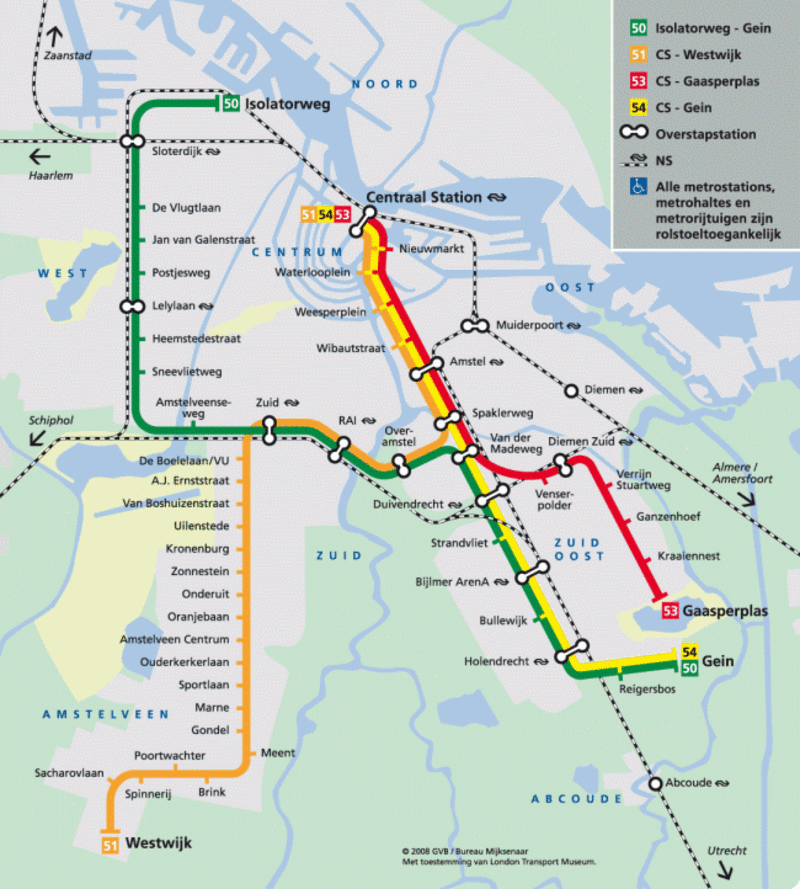The Amsterdam Metro is the underground system and light rail that runs through the Dutch capital of Amsterdam. It is an extremely well-used form of transportation by the people living within the city and its neighboring areas. The network connects distant zones with bordering ones and the system includes a total of 58 stations that are grouped together across five lines. 39 stations are part of the metro and 19 are part of the light rail.
This metro was founded in 1977 and has a current length of 50.5 kilometers (31.38 miles), of which 40.9 (25.41) are exclusively a part of the metro. This system is also responsible for connecting Amsterdam to the foreign municipalities of Amstelveen, Diemen, and Ouder-Amstel. Buses, trams and ferries complement the metro system. The minimum fare for an hour is 3 euros ($US 3.52) and service runs from 5:30 am to 12:30 am.
Metros in the Netherlands: Amsterdam
Amsterdam is the capital of the Kingdom of the Netherlands as well as the most populated city. It is globally renowned as a multicultural metropolis. Of the five continents, it welcomes millions of tourists year after year.
Though it is the capital, it is not the government headquarters, which is found in the city of Haya. Amsterdam is a city with 851,373 inhabitants within its city limits with up to 1,351,587 in the urban area and 2,410,960 in the metropolis area.
The city was born a small fishing town in the twelfth century, but its port activity grew and expanded beyond the 17th century. The city is mainly composed of canals which serve as entryways to the sea. The canals have been declared a Unesco World Heritage Site.
Amsterdam is also the commercial capital of the Netherlands, and a principal European financial and business center. The commercial port continues to be the second most important in the country, after Rotterdam. Additionally, the culture stands out greatly as the home of various museums such as Van Gogh, Stedelijk, the Hermitage and its own Amsterdam Museum.
The city is also well known for the legal consumption of marijuana and the Red Light District, an area of the city where prostitution and some drug consumption is completely permitted.
On average, the city’s temperature ranges from 3.4 to 7°C (38 to 44.6°F) during the the cold months while the warmer months range between 12.9 and 17.6 °C (55.22 and 63.7 °F).
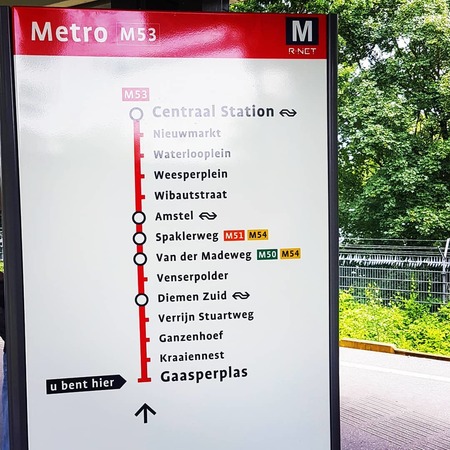 Gaasperplas metro station
Gaasperplas metro station
The metro
The Amsterdam Metro is an immense transportation system serving the capital city of the Netherlands and its suburbs. This metro has five lines: 50, 51, 52, 53 and 54 and the system alternates between underground stations with surface stations or single stops.
The metro has various rolling stocks, according to its internal distinctions. Currently, there are four distinct series of trains. Primarily, there are the S1 and S2 trains, which are manufactured by the US company, BN, and which operate on Line 51. These trains are small and have just a two-car capacity. This is also true for the S3 and M4 series, manufactured by the Spanish company CAF, which run on lines 50, 51 and 53. Lastly, is the most recent S3 series, which are trains, manufactured by the French company, Alstom.
They have six cars and operate on all the lines. These trains are the system’s largest and have been in operation since 2015. Gemeentevervoersbedrijf (GVB) is the system operator. The name translates to Municipal Transport Company. It was a dependency of the municipality, but it became incorporated in 2007. Even so, all its activities are maintained by the Amsterdam government.
The system has approximately 194,000 passengers daily, which translates into 71 million passengers annually.
- Known as: Metro
- Length: 50.5 kilometers (31.38 miles) (40.9 {25.4 miles}is part of the metro)
- Rail width: 1435 mm (4.71 ft.)
- Number of lines: 5
- Number of stations: 58 (39 are a part of the metro)
- Maximum speed: 70 km/h (43.5m/hr)
- Website: www.gvb.nl
- Operator: GVB (German Transport Company)
- Daily ridership: 194,000
- Founded: October 14, 1977
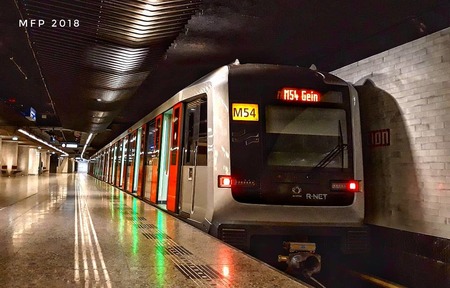 Station Amsterdam Centraal
Station Amsterdam Centraal
Brief history
The planning and construction of Amsterdam’s Metro system has a long history. The first construction initiatives began in the 1920s. The creation of a line was proposed in 1922, and a circular line and one other running along the north-south corridor was planned in 1928. All the initial projects were rejected due to the high costs.
Amsterdam was one of the European capitals that did not have a large underground metro system in the 50s and since then, the municipal government began to lay out the need to create one. The first municipal city reports for the creation of a metro began to come to light and be publicized in 1966, and by 1968, a project had already been presented.
This original plan laid out the construction for four lines which would take the place of most of the city’s trams. The four routes covered by the line included an east-west line departing from Zuidoost to Osdorp and passing through Centraal Station, one moving between Westelijk Havengebied and Diemen, a north-south one which also passed through Central Station to connect Amsterdam Noord and Weteringplantsoen, and an east-west line, between Geuzenveld and Gaasperplas.
Construction began in 1970 with a line that connected to the east, passing through the city center. The system was inaugurated and opened in 1977. Beginning in 1980, the routes that had been constructed ended at Centraal Station. Strong protests broke out during construction when Nieuwmarkt neighborhood, located in the city center, was demolished. Since then, construction and planning of new routes and lines has continued. On July 20, 2018, Line 52 became the most recently inaugurated line.
Lines and stations
The Amsterdam Metro has 5 operating lines to its credit. It is a mixed rapid metro and light rail system. The metro lines include the following:
50
Also known as the Ring Line, (Ringlijn, in Dutch), Line 50 was the most recent to be inaugurated, when it began operating in 1997. The route is also recognized as part of the Eastern line, as it departs from Gein station in the south. The terminal station, Isolatorweg, is located in the north. Altogether, there are 20 stations. Line 50 is the system’s busiest line and its 20.4 kilometers (12.7 miles) make it the longest line on Amsterdam Metro. This line can be identified on station maps by the color green and a square with three vertical stripes, colored blue, red and blue.
51
Also known as part of Eastern line, the Amsetlveen Line (Amstelveenlijin, in Dutch) is 19.5 kilometers (12.1 miles), making it the second longest line in the system. Running north from Centraal Station to Westwijk, in the southeast, its 29 stations also make it the route with the greatest number of stops. Inaugurated in 1990, this is Amsterdam Metro’s second oldest line. It can be identified by the color orange and a square that is divided diagonally, with the color red in the top left and the color white in the lower right.
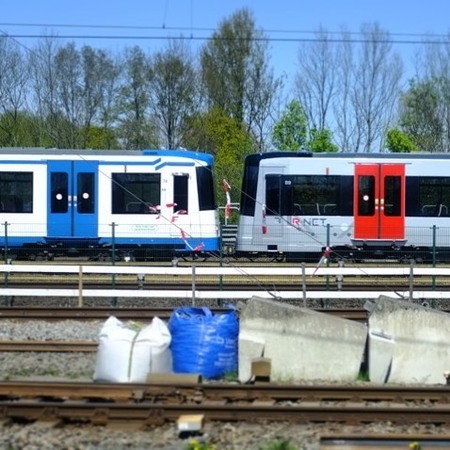
52
52 is Amsterdam Metro’s most recently constructed line. It was inaugurated on July 20, 2018 and includes eight stations. The route is the North-South Line (Noord/Zuidlijn, in Dutch). The terminal stations are Noord, in the north and Station Zuid in the south. At just 9.5 kilometers (5.9 miles), this is the system’s shortest line. It can be identified by its light blue color and a square formed by two vertical lines with yellow on the left side and blue on the right.
53
In 1977, this line became one of the first of two to be inaugurated. As another part of the East line, it serves the eastern branch of Gaasperplas (Gaasperplaslijn, in Dutch). It circulates from Centraal Station to the north and ends in Gaasperplas in the southeast. This is the system’s second shortest metro line with 14 stations and a length of 11.3 kilometers (7 miles). It can be identified by the color red and a square formed by two horizontal lines, colored blue on the top half and colored white on the bottom.
54
54 is the system’s fourth line, although it was the first to be inaugurated in 1977 along with Line 53. This line overlaps most of Line 50 as part of the Gein station. However, it ends at Centraal Station. As the third longest line, its 12.1 kilometers (7.5 miles) consist of 15 stations. It is distinguished by the color yellow along with a square made up of three vertical lines colored white, red and white.
Connections with other systems
Due mainly to the metro not connecting directly to the city center but rather more of a connection to distant areas, the Amsterdam Metro is supplemented by other GVB managed transportation systems. The tram is the most significant. The trams began operating in 1875 and in 1943, it began operating with the GVB, which today fully manages it. There are 14 tram lines in Amsterdam, grouped together along a route of 80.5 kilometers (50 miles). Lines 1, 2, 4, 5, 9, 13, 16, 24 and 26 connect to the metro via Centraal Station.
Line 3 connects to the metro at Wibautstraat (51, 53 and 54) station. Likewise, Line 7 connects at Weesperplein (51, 53 and 54) station, and Line 10. De Vlugtlaan station (50) also connects to Line 7. Line 12 connects to Sloterdijk (50) and Amstelstation (51, 53 and 54) stations. Line 14 connects to the metro at Mr. Visserplein (51, 53 and 54) and to the De Vlugtlaan station (50).
GVB also manages the bus network. There are 46 routes that occasionally connect with the trams and the other transportation methods.
However, if just taking the land routes, one will miss out on one of the most significant modes of transportation: the ferry. There are ten ferries, which permanently travel along IJ bay, Amsterdam’s waterfront. These ferries connect the city center to the north, without the hassle of taking various routes, including Centraal Station.
It is also important to note that 60% of travel within the city is by bicycle, while an estimated 40% is outside the city and some metro stations have bike parking facilities.
Connections to the airport
The Amsterdam Airport Schiphol in Amsterdam supplies air travel to the city. It can be found just 9 kilometers (5.6 miles) southeast of the city, in the Haarlemmermeer municipality. This is the third busiest airport in all of Europe and the 14th busiest in the world. The airport was founded as a military air base in 1916 and now serves as the operating center for the Dutch airline, KLM.
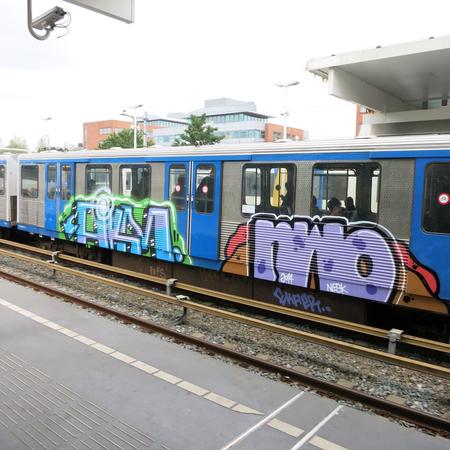
There are various ways to connect from Schiphol Airport to the Amsterdam Metro. The train, which travels from Schiphol Airport station, is the best route. A trip can began from here to Centraal Station via the Intercity, Intercity and Sprinters direct trains. The metro can also be reached by bus. Bus lines 397 and N97 connect to the city center. Similarly, the Osdorp neighborhood can be reached with bus lines 69, 194, 195 and N95. Line 69 also connects Slotevaart and the airport, while the Amsterdam-Zuid and the Buitenvelder neighborhoods are connected by line 341. Lastly, the southeast part of the city, known as Amsterdam-Zuidoost, is connected by bus lines 300 and N30.
Schedule and frequency
The Amsterdam Metro schedules vary in relation to the line in which they serve but always remain within the same range. Line 50’s first train departs from Duivendrecht Station at 5:31 am, while the last one reaches Gein station at 12:50 am. On Saturdays, the first train leaves from Zuid station at 6:07 am and on Sundays, it leaves from the same station at 7:07 am. Closing time remains the same. On weekdays, the frequency between train arrivals is ten minutes from opening until 10:00 am, at which time, it changes to every 15 minutes. Beginning again at 3:15 pm, the frequency returns to every 10 minutes until 5:45 pm, when it becomes every 15 minutes for the rest of the day. It maintains a frequency of every 15 minutes all day on Saturdays and Sundays.
The first train departs from RAI station at 5:51 am and the last train arrives at Central Station at 12:52 am on Line 51. On Saturdays and Sundays, the first train departs from RAI station as well but at 6:23 am and 7:23 am, respectively. Closing time remains the same. During the week, the frequency is every ten minutes until 8:45 am, at which time, it changes to every 15 minutes until 2:50 pm. The frequency is then every ten minutes, until 5:45 pm, in which it changes back to every 15 minutes until closing. On Saturdays and Sundays, it arrives every 15 minutes.
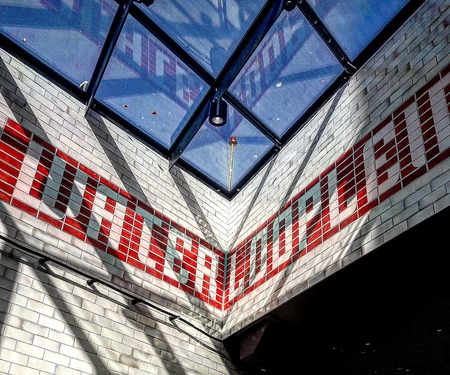
The modern day Line 52 begins operating from Noord station at 5:30 am and ends at Zuid station at 1:00 am. It also departs from Noord station on Saturdays and Sundays, but at 6:30 and 7:30 am, respectively. Closing time is the same on both days. The frequency is every six minutes on weekdays, but after 10:00 pm, it lengthens to every seven to ten minutes. On Saturdays and Sundays, the trains arrive every seven to eight minutes.
Service on Line 53 begins at 5:50 am at Gaasperplas station and ends at 12:32 am at Centraal Station. It also begins at Gaasperplas station on Saturdays and Sundays, at 6:26 and 7:26 am respectively and the closing time is the same as weekdays. The frequency from Mondays to Fridays is every ten minutes until 9:10 am, at which time, it changes to every 15 minutes. It then runs every ten minutes between 3:10 and 6:10 pm, followed by every fifteen minutes until closing. Trains arrive every 15 minutes on Saturdays and Sundays.
Line 54 metro service begins with the first train departing from Gein station at 5:55 am. The last train arrives at Centraal Station at 12:28 am. Saturday service begins with the first train leaving Amstelstation at 6:24 am while Sunday service begins from the same station at 7:25 am. Closing time is the same as weekdays. Trains run every 10 minutes until 9:10 am on weekdays. Then, they run every 15 minutes. The frequency is every ten minutes from 3:05 pm until 6:05 pm, at which time, it goes back to every fifteen minutes until closing. Trains run every fifteen minutes on Saturdays and Sundays from opening to close.
Fees, tickets and cards
Like the world’s other large transportation systems, the Amsterdam Metro offers many purchase options to its riders, depending on the time of use.
All the single tickets are designated with a certain timeframe and they can all be used on GVB’s transportation systems. The most basic ticket is for an hour and costs 3 euros ($US 3.52). The cost for an entire day is 7.50 euros ($US 8.80) while it drops to 3.75 euros ($US 4.40) for children.
A two-day ticket is 12.50 euros ($US 14.68), three days is 17.50 euros ($US 20.55), four days is 22.50 euros ($US 26.42), and five is 27.50 euros ($US 32.29). It costs 31.50 euros ($US 36.98) for six days and a seven-day ticket costs 34.50 euros ($US 40.51).
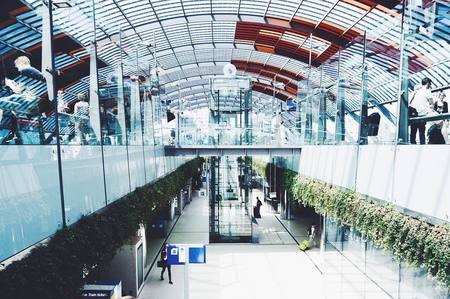 Station Amsterdam Centraal
Station Amsterdam Centraal
Riders have additional fare options, especially if they reside in Amsterdam or spend long periods of time in the city and in its surroundings. There is the GVB Zone season ticket, which is an unlimited monthly ticket for travel between zones 5710, 5711, 5712, 5713, 5714, 5715 and 5725. It is priced at 47 euros ($US 55.18) per month with a reduced rate of 30.50 euros ($US 35.81) for riders between the ages of 4 and 18 or over the age of 65.
Additionally, there is the Only Season Ticket which offers unlimited travel on all GVB transportation systems, but not on those of other companies such as EBS or NS. The Only Season Ticket costs 93 euros ($US 109.19) per month while the reduced price is 61 euros ($US 71.62).
There is also the Network season ticket, which can be used on all GVB systems and those of other companies. Its price is 280.80 euros ($US 329.69), while its reduced rate is 185.35 euros ($US 217.62).
Frequent travelers get a considerable discount through the Altijd Korting. This discount translates into 17.50 euros ($US 20.55) monthly, and 175 euros ($US 205.45) per year.
The hourly trip ticket combined with bicycle travel costs 4.70 euros ($US 5.52), while day long travel supplemented with a bicycle costs 1.70 euros ($US 2.00).
There is also a night line bus ticket, priced at about 4.50 euros ($US 5.28). A 12-trip night line ticket costs 34 euros ($US 39.92).
Amsterdam residents typically use the OV-chipkaart which can remain unregistered or be registered with their personal contact information. If personalized, one can cancel it in the case of loss and additionally have the option of loading various season ticket types on it. This card is usually charged through the e-purse, which tracks each kilometer traveled or the number of trips. The cost can be 0.90 euros ($US 1.06) per trip, or 0.155 euros ($US 0.182) if it’s per kilometer. The reduced fare is 0.59 euros ($US 0.69) per trip or 0.102 euros ($US 0.120) per kilometer.
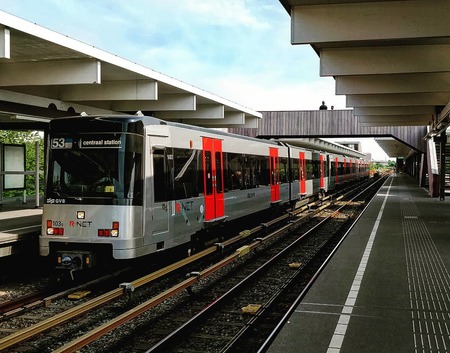 Van der Madeweg metro station
Van der Madeweg metro station
Tourists have distinct options for travel throughout GVB’s transportation system. The Amsterdam Travel Ticket allows use of all transportation modes in the Dutch city, including train and bus travel from the airport. The day ticket can be purchased for 16 euros ($US 18.79), a two day ticket costs 21 euros ($US 24.66) and a three day ticket costs 26 euros ($US 30.53).
The Amsterdam & Region Travel Ticket is very similar but doesn’t include a trip to the airport. It allows travel throughout the entire region and outside the city. This day ticket costs 18.50 euros ($US 21.72), a two day ticket costs 26 euros ($US 30.53) and a three day ticket costs 33.50 euros ($US 39.33).
Lastly, there is the Amsterdam Card, which allows use of the entire GVB system in addition to providing discounts on admission to museums and travel through the canals. The day ticket cost 59 euros ($US 69.27). A two-day ticket cost 74 euros ($US 86.88), a three-day ticket cost 87 euros ($US 102.15) and a four-day ticket cost 98 euros ($US 105.06).
System regulations
The GVB has established various operating standards and procedures to regulate the Amsterdam Metro. The following are some of the system’s regulations:
- Smoking is prohibited in all metro facilities
- Eating and drinking is permitted. One should be cognizant so as to not make messes in stations or on trains as well as to not disturb other riders with strong odors. Hot drinks should be carried in closed containers in order to avoid spills.
- To enter the system, riders must have a valid travel ticket for the trip they plan to make.
- Only one person can pass through the turnstiles at a time, unless the individual is a child under the age of four.
- One must maintain an appropriate noise levels such as not listening to loud music that could disturb other riders.
- Bicycles are permitted except during peak hours (from 7:00 am to 9:00 am and from 4:00 pm to 6:30 pm).
- Feet should not be placed on seats.
- Strollers and wheelchairs share the same preferential space and wheelchairs have priority over strollers.
- No type of alcohol or drugs may be consumed.
- Taking photographs and video taping without the authorization of GVB is prohibited.
- Security cameras are recording riders at every moment.
Future expansions
Line 52 was opened on July 22, 2018, following construction that began in 2002. This represented the largest renovation in decades, and Amsterdam Metro’s much desired expansion of a line that would run along the north-south corridor. Another future objective is for Line 52 to be extended to the Amsterdam Airport Schiphol.
Additionally, the tram that runs east to IJburg neighborhood, was originally planned as a metro line. Construction began, but the tunnel was eventually abandoned and used as part of the Chocolate Museum. However, there are plans to revisit the construction of the line to extend it to Almere city, next to Amsterdam.
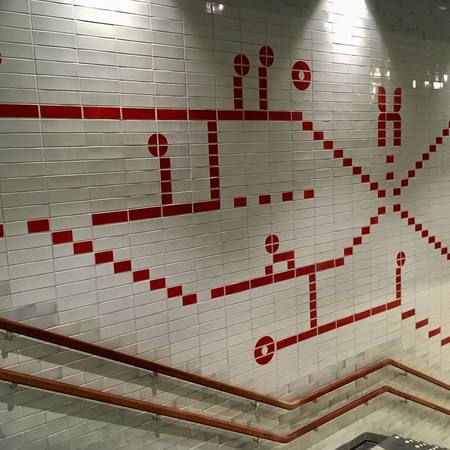
Tips
- It is important to plan trips in advance and purchase tickets accordingly. One must keep in mind that most tickets have a time limit that must be followed.
- Unlike other metros, such as those in Germany, the Amsterdam Metro has entry and exit turnstiles, in which tickets must be presented both while entering and exiting.
- Although eating is permitted, one must make sure not to disturb other passengers with food or drinks.
- Train punctuality is very precise, so someone with a strict timeline should try not to be late.
- Learning some basic Dutch vocabulary is recommended, in order to facilitate communications within the Amsterdam Metro.
Notable facts
- This transportation system is one of the very few in the world that allows eating within its facilities.
- GVB management company manages the metro, trams, buses and ferries.
- Unlike many other metro systems in Europe’s capitals, Amsterdam is the most recent, having been inaugurated in 1977.
- 21 years after the last line was inaugurated, a new line was inaugurated in 2018.
- Stations like Rokin, on Line 52, showcase archaeological discoveries that were found during excavations.
Siteseeing via Amsterdam Metro
Amsterdam is globally renowned and visited by millions of tourists. Its liberal idiosyncrasy, friendly to marijuana and prostitution, as well as the stillness captured in it canals, grant it a distinct style within Europe and across the world.
Its high standards of living also attract many potential residents. Amsterdam stands out in a multitude of ways and its transportation systems are what most accompanies this variety. The trams are more concentrated in the city center and the metro serves as more of a connection to the residential and suburban zones. However, utilizing the metro will still allow one to reach various significant sites. Some of these include:
- Museum of Prostitution - Red Lights Secrets: Many tourists visiting Amsterdam, though they have no intention in procuring prostitution services, wish to find out more about this world and its context. With that objective in mind, this museum, exhibiting the life of a worker in Amsterdam’s sex service industry as well as the historical relations from which this developed, was inaugurated in 2014. To reach the museum, one can get off at Niewumarkt station from Line 51, 53 or 54 and walk a few blocks west.
- Amsterdam Museum: The city of Amsterdam has a rich history that can be drawn from its Amsterdam Museum facilities. This museum has been in operation since 1926, but in 1975, the headquarters were moved to the current location, which is an old orphanage convent. The museum’s collection exhibits the city’s history from the Middle Ages to the present, with paintings, models, archaeological discoveries such as a Wiktar ecological car and a replica of the Café 't Mandje bar, where prostitutes, lesbians and women, in general, met in the early 20s. To reach this museum, one must get off at Rokin station on Line 52 and walk north.
- Botanic Garden (Hortus Botanicus Amsterdam): One can enjoy Amsterdam’s natural landscape in a quaint space of just 1.2 hectares (3 acres). The garden is private and, as a nonprofit, requires an entry fee for administrative costs. Founded in 1638, this park is one of the oldest in the world. The most distinguishing areas to stand out in this garden are the tropical sections and the desert sections, containing palm trees. Most of the plants are derived from Old Dutch colonies in America and Africa. Access to the Botanic Garden is free with the I Amsterdam Card and to reach it, one can get off at Waterlooplein station, from Line 51, 53 or 54, and walk east.
Amsterdam metro map
- Passengers/Day 233000
- Fares: 2.09 EUR (2009); gates, nationwide smartcard (OV-chipkaart sucesor de strippenkaart)
- 24h operation: No
- Air Conditioning: No
- Walk between platforms: No
- Driverless trains: No
- Screen Doors Platforms: No
- Max. Speed: 70km/h
- Operator: Gemeentelijk Vervoerbedrijf
- € 7
- Amsterdam Metro Official Website
Help us
If you consider that the information we provide is wrong, not accurated, outdated, translation contains errors, and you would like to help us to improve the file...you can contact us here.
Feel free to contact us if you dont find the system you're looking for and we'll add it as soon as we can!
Thank you very much!







